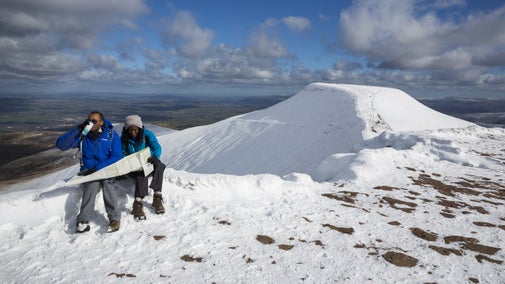Cwm Idwal walk
Wales
This moderately strenuous walk offers some of the most dramatic mountainous scenery in the UK at the oldest National Nature Reserve in Wales. Explore beautiful ice-sculpted Cwm Idwal – a bowl-shaped hollow filled with the crystal clear waters of Llyn Idwal, world famous for its rock formations and rare and fragile plant life.
Near to
Carneddau and GlyderauStart point
Ogwen Cottage and Ranger Base, grid ref: SH 650603Trail information
*This is a moderately strenuous walk with some steep sections. For further details, please see Terrain section.
**There are steep sections along rough mountain paths, leading up to the lake. For further details, please see section marked Access.
***Dogs are welcome but should be kept on a lead at all times. For further details, please see section marked Facilities.
Avoid parking worries by hopping on the bus
At busy periods, the limited parking fills quickly. Remember the T10 bus service runs frequently between Bangor and Corwen. For further details, please see 'Getting there' section.
More near here
Llyn Ogwen circular walk
Escape the crowds of Cwm Idwal and enjoy stunning views on this moderate walk around Llyn Ogwen. Legends say it’s the last resting place of King Arthur’s sword Excalibur.

The legendary trail of Dinas Emrys
Enjoy a pleasant walk past waterfalls and through beautiful oak woodland to reach this summit of this legendary hill, where Merlin once trod and where a dragon still sleeps.

Aberglaslyn, Llyn Dinas and Cwm Bychan walk
Explore Aberglaslyn gorge, the waters of Llyn Dinas, the beautiful village of Beddgelert and Cwm Bychan copper mine on this challenging route in Eryri (Snowdonia).

Bws Ogwen shuttle service
Avoid parking issues and travel more sustainably with Bws Ogwen, a local electric bus service running between Bethesda and Capel Curig. Return tickets: Adult - £3, child £2 (under 2s free). Dogs welcome. Wheelchair access available, email cludiant@ogwen.org to arrange beforehand.

Get in touch
National Trust, Bwthyn Ogwen, Nant Ffrancon, Bethesda, Gwynedd, LL57 3LZ
Our partners

We’ve partnered with Cotswold Outdoor to help everyone make the most of their time outdoors in the places we care for.
You might also be interested in
Cotswold Outdoor: our exclusive walking partner
Learn about the National Trust’s ongoing partnership with Cotswold Outdoor. Find out how they help us care for precious places and the exclusive discount available for National Trust supporters.

Staying safe at National Trust places
The special places in National Trust care sometimes come with a few risks for visitors, be it coastline or countryside. Find out how to keep safe throughout your visits.

Follow the Countryside Code
Help to look after National Trust places by observing a few simple guidelines during your visit and following the Countryside Code.

Walking and climbing on Tryfan
What makes the Tryfan mountain so special? Discover the history of this rugged peak and the challenges it raises for climbers and mountaineers who attempt to conquer it.

History and legends of Cwm Idwal
Discover Cwm Idwal’s past, Darwin’s discovery of its creation and the legend of a 12th-century prince, his son and the giant that occupied the land.

Walking
Explore some of the finest landscapes in our care on coastal paths, accessible trails, woodland walks and everything in between. Find the best places to walk near you.

Walking in Wales
Explore wide open landscapes, gentler coastal strolls or energetic hikes for something a little more challenging. We've rounded up some of the best places to walk in Wales.

Holiday cottages in Eryri (Snowdonia)
With its towering mountains, deep gorges and pristine lakes, Parc Cenedlaethol Eryri (Snowdonia National Park) is an ideal holiday destination for outdoor enthusiasts and nature lovers alike. Stay at one of our holiday cottages in Eryri (Snowdonia) and explore this special part of Wales.


